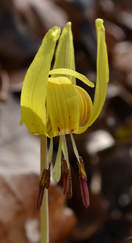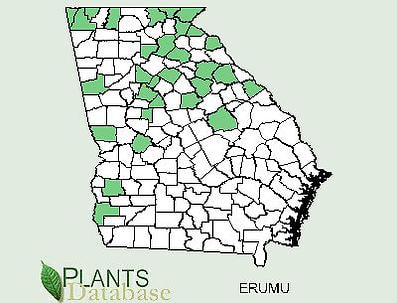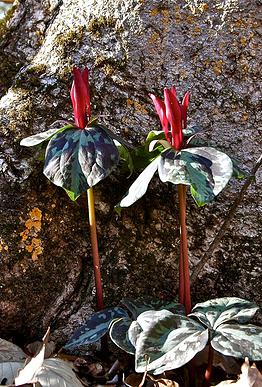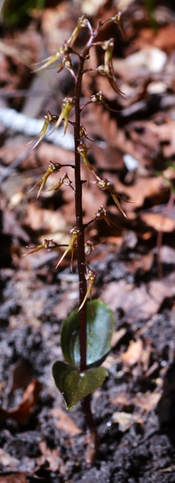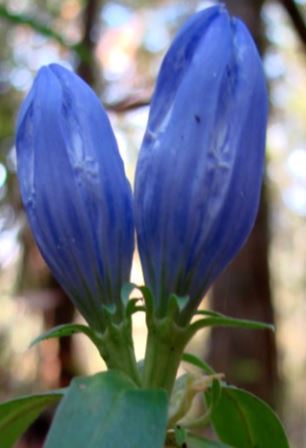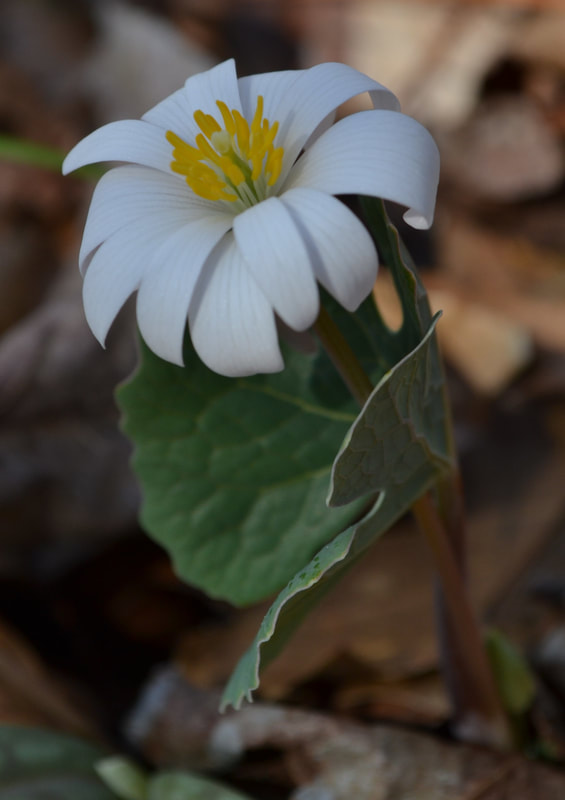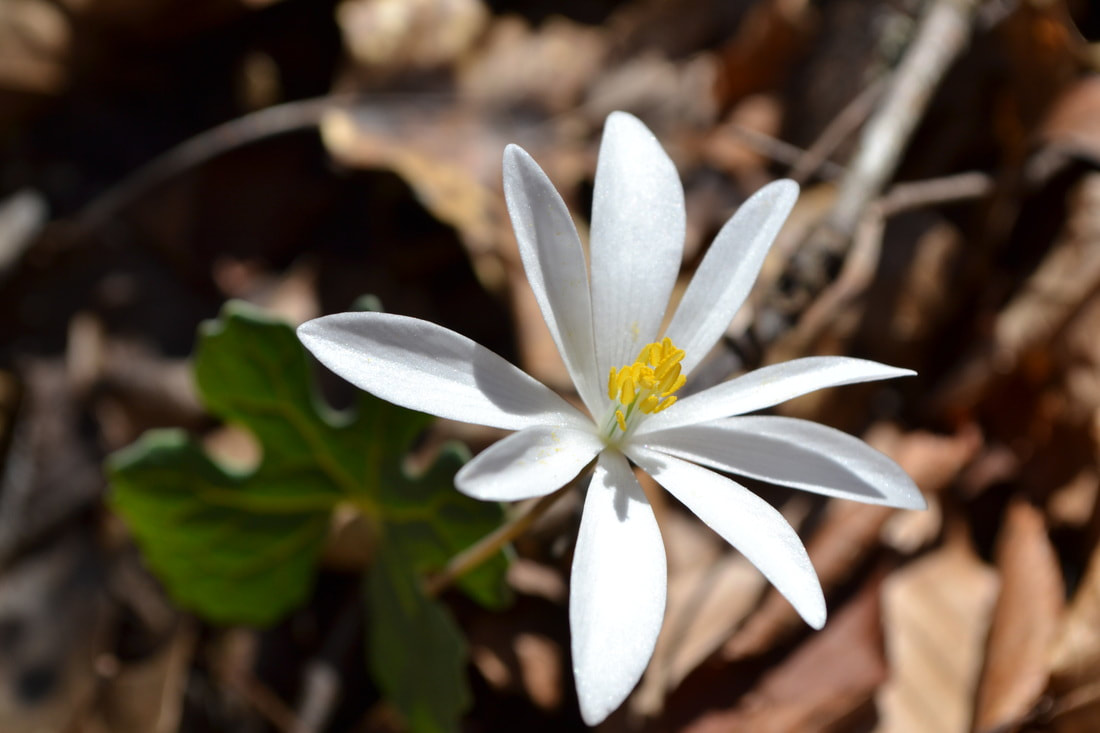Trout Lilies
There are 20-30 species of trout lilies, also called fawn lily, dog's tooth violet (although they are not related to violets), and adder's tongue. Most species are found in the USA and Canada. There are 18 species west of the Rocky Mountains, 6 species east of the Rocky Mountains, one in Europe, and three in Asia. The genus name is Erythronium. It is a genus of bulbous spring-flowering perennials. They have attractive pendant flowers and sometimes mottled leaves. They prefer shade or dappled sun. In Japan, Erythronium japonicum is called katakuri, and the bulb is processed to produce starch. which is used for food and other purposes. They are also grown as ornamental plants, with numerous hybrids and cultivars selected for garden use. The species at Wolf Creek Trout Lily Preserve is Erythronium umbilicatum, dimpled trout lily. Its range includes MD, DC, VA, WV, NC, SC, KY, TN, GA, FL and AL.
There are 20-30 species of trout lilies, also called fawn lily, dog's tooth violet (although they are not related to violets), and adder's tongue. Most species are found in the USA and Canada. There are 18 species west of the Rocky Mountains, 6 species east of the Rocky Mountains, one in Europe, and three in Asia. The genus name is Erythronium. It is a genus of bulbous spring-flowering perennials. They have attractive pendant flowers and sometimes mottled leaves. They prefer shade or dappled sun. In Japan, Erythronium japonicum is called katakuri, and the bulb is processed to produce starch. which is used for food and other purposes. They are also grown as ornamental plants, with numerous hybrids and cultivars selected for garden use. The species at Wolf Creek Trout Lily Preserve is Erythronium umbilicatum, dimpled trout lily. Its range includes MD, DC, VA, WV, NC, SC, KY, TN, GA, FL and AL.
The leaves are said to resemble speckled trout, with small dimples, and the corm is seen as looking like a dog's tooth. There is a thin connection between the corm and the plant, like an umbilical cord, thus umbilicatum. They live in scattered colonies, usually in cool weather environments. There are a few colonies in Florida, most notably near the Apalachicola River and at Angus Gholson Park in Chattahoochee, where on about two acres they are mixed with other vegetation, and don't stand out like they do at Wolf Creek, where we find them as an open ground cover. Trout lilies are endangered in Florida and were considered to be extremely rare in South Georgia before the discovery of the vast colony at Wolf Creek. The USDA Plants Database range map still does not show any presence in Grady County.
The huge colony at Wolf Creek is considered to be a product of a phenomenon called Pleistocene refugia. Thousands of years ago, as the Southern climate became warmer and the glaciers retreated north, some colonies of what are now more northern plants remained in locations that were
suited to them.
Apparently, Wolf Creek is an ideal environment, as this is the largest expanse of dimpled trout lily known anywhere. There are many millions of the plants at Wolf Creek covering over 10 acres. A square foot may have 100 plants. The slope is north-facing, the canopy mostly hardwoods and spruce pine with a heavy layer of leaf litter, the pipe clay under the soil's surface must hold just the right moisture in winter, when the plants emerge and grow. The gray pipe clay or Fuller's earth is dense and plastic. Moisture cannot penetrate through it, so the water flows downhill over the clay layer, holding the moisture above it. At Wolf Creek the clay is only six inches to two feet under the surface of the soil. Trout lilies can tolerate high temperatures and drought in the dormant season, due to their corms. At Wolf Creek, invasive exotics which might choke out the trout lilies or inhibit their spread are not in great numbers on the slope (but privet are encroaching from the floodplain and Japanese honeysuckle is thinly scattered, even on the slope.) This colony may have been growing in this location for thousands of years and has survived at least 175 years of human presence.
The trout lily's fleshy green leaves with purple mottling make it easy to recognize. Its graceful yellow flower sits atop a solitary stem and droops towards the ground. Its petals, however, curl upwards, revealing the bright yellow of the inner petals, as a member of the lily family, the trout lily flower displays a common characteristic of having three petals and three petal-like sepals.
Trout lilies are a harbinger of spring. The plant is only visible for a few months, usually late December or early January to late March or early April. Therefore it is known as a spring ephemeral. The leaves are freeze-resistant, so are not destroyed by late freezes. An especially cold winter may delay the bloom, but will not harm the plants. The leaves die back every year after the bloom and the plant enters dormancy. After that, the plants focus their energies on spreading underground, and making new shoots for the next year.
This is a plant that relies on both the spreading abilities of its underground root system (corms) as well as on seed production from its flowers. The plants naturally spread by forming colonies of plants of different ages. The first year plants have only one leaf, which looks like a single blade of grass. The single leaf size increases for the next few years, while older plants produce two leaves. Each plant must be at least four or five years old before it will start producing its single flower and seed capsule. The mature plant sends up a single leaf in January, then a couple of weeks later, the second leaf, surrounding the flower bud. The leaf falls back as the flower emerges. Each individual flower blooms for four or five days. It closes at night, and does not open again until early afternoon of the next day, if there is sun. On a very overcast day, it may not open until the sun comes out or not at all. The flower follows the sun through the afternoon, then closes at dusk. Individual plants bloom at different times, so in the large colony at Wolf Creek, the bloom extends for three or four weeks. The lifespan of individual plants is not known, but may encompass decades.
The flower is pollinated by flying insects and wind (as are many lilies). It produces a seed capsule on the end of the stalk, which falls to the ground as the capsule matures and fades from green to white. The capsules are about the size and shape of a small chickpea, and contain 5-25 seeds, about a sixteenth of an inch in size. The seeds are spread by ants, who eat a nutritious appendage attached to each seed and leave the rest to germinate, often at several feet distance from the original plant. When the plant goes dormant at the end of the growing season, its energy is transferred to the bulb-like corm.
A corm (or bulbo-tuber) is a vertical swollen underground plant stem that is modified into a mass of storage tissue. It is a storage organ that allows the plant to survive adverse conditions such as northern winters and summer drought and heat. A corm is internally structured with solid tissue. This distinguishes it from a true bulb, which is mostly made up of layered fleshy scales that are modified leaves. When a corm is cut in half, it is solid, but when a true bulb is cut in half, it shows visible rings. Examples of plants that develop from corms include gladiolus, crocus, banana, Chinese water chestnut, freesia, liatris, saffron, arrowhead, and taro (elephant ear).
The corm contains a basal plate, the bottom of the bulb from which roots develop, and a growing point. This is surrounded by thin skin or tunic leaves, produced the year before. This provides a covering that protects the corm from insects and water loss. Corms form cormels that produce new plants. A mature trout lily corm is about .25" long. Corms produce two different types of roots. Those growing from the basal area at the bottom of the corm are normal fibrous roots, that are formed as the shoots grow. The second type of roots are thicker layered roots called contractile roots, which pull the corm deeper into the soil. They are produced in response to fluctuating soil temperatures and light levels. Once the corm is deep enough within the soil, where the temperature is more uniform, and there is no light, the contractile roots no longer grow, and the corm is no longer pulled deeper into the soil. A plant's corm has to reach sufficient depths (10 to 20 centimeters below ground) before it will devote energy to making the second leaf and flower.
Sources: Dan Miller, USDA Plant Database, Wikipedia, Bulbs and More website, Wilson Baker, Dr. Gil Nelson, Lou Kellenberger from Wild About Gardening, Canadian Wildlife Federation, Plant Delights Nursery.
The huge colony at Wolf Creek is considered to be a product of a phenomenon called Pleistocene refugia. Thousands of years ago, as the Southern climate became warmer and the glaciers retreated north, some colonies of what are now more northern plants remained in locations that were
suited to them.
Apparently, Wolf Creek is an ideal environment, as this is the largest expanse of dimpled trout lily known anywhere. There are many millions of the plants at Wolf Creek covering over 10 acres. A square foot may have 100 plants. The slope is north-facing, the canopy mostly hardwoods and spruce pine with a heavy layer of leaf litter, the pipe clay under the soil's surface must hold just the right moisture in winter, when the plants emerge and grow. The gray pipe clay or Fuller's earth is dense and plastic. Moisture cannot penetrate through it, so the water flows downhill over the clay layer, holding the moisture above it. At Wolf Creek the clay is only six inches to two feet under the surface of the soil. Trout lilies can tolerate high temperatures and drought in the dormant season, due to their corms. At Wolf Creek, invasive exotics which might choke out the trout lilies or inhibit their spread are not in great numbers on the slope (but privet are encroaching from the floodplain and Japanese honeysuckle is thinly scattered, even on the slope.) This colony may have been growing in this location for thousands of years and has survived at least 175 years of human presence.
The trout lily's fleshy green leaves with purple mottling make it easy to recognize. Its graceful yellow flower sits atop a solitary stem and droops towards the ground. Its petals, however, curl upwards, revealing the bright yellow of the inner petals, as a member of the lily family, the trout lily flower displays a common characteristic of having three petals and three petal-like sepals.
Trout lilies are a harbinger of spring. The plant is only visible for a few months, usually late December or early January to late March or early April. Therefore it is known as a spring ephemeral. The leaves are freeze-resistant, so are not destroyed by late freezes. An especially cold winter may delay the bloom, but will not harm the plants. The leaves die back every year after the bloom and the plant enters dormancy. After that, the plants focus their energies on spreading underground, and making new shoots for the next year.
This is a plant that relies on both the spreading abilities of its underground root system (corms) as well as on seed production from its flowers. The plants naturally spread by forming colonies of plants of different ages. The first year plants have only one leaf, which looks like a single blade of grass. The single leaf size increases for the next few years, while older plants produce two leaves. Each plant must be at least four or five years old before it will start producing its single flower and seed capsule. The mature plant sends up a single leaf in January, then a couple of weeks later, the second leaf, surrounding the flower bud. The leaf falls back as the flower emerges. Each individual flower blooms for four or five days. It closes at night, and does not open again until early afternoon of the next day, if there is sun. On a very overcast day, it may not open until the sun comes out or not at all. The flower follows the sun through the afternoon, then closes at dusk. Individual plants bloom at different times, so in the large colony at Wolf Creek, the bloom extends for three or four weeks. The lifespan of individual plants is not known, but may encompass decades.
The flower is pollinated by flying insects and wind (as are many lilies). It produces a seed capsule on the end of the stalk, which falls to the ground as the capsule matures and fades from green to white. The capsules are about the size and shape of a small chickpea, and contain 5-25 seeds, about a sixteenth of an inch in size. The seeds are spread by ants, who eat a nutritious appendage attached to each seed and leave the rest to germinate, often at several feet distance from the original plant. When the plant goes dormant at the end of the growing season, its energy is transferred to the bulb-like corm.
A corm (or bulbo-tuber) is a vertical swollen underground plant stem that is modified into a mass of storage tissue. It is a storage organ that allows the plant to survive adverse conditions such as northern winters and summer drought and heat. A corm is internally structured with solid tissue. This distinguishes it from a true bulb, which is mostly made up of layered fleshy scales that are modified leaves. When a corm is cut in half, it is solid, but when a true bulb is cut in half, it shows visible rings. Examples of plants that develop from corms include gladiolus, crocus, banana, Chinese water chestnut, freesia, liatris, saffron, arrowhead, and taro (elephant ear).
The corm contains a basal plate, the bottom of the bulb from which roots develop, and a growing point. This is surrounded by thin skin or tunic leaves, produced the year before. This provides a covering that protects the corm from insects and water loss. Corms form cormels that produce new plants. A mature trout lily corm is about .25" long. Corms produce two different types of roots. Those growing from the basal area at the bottom of the corm are normal fibrous roots, that are formed as the shoots grow. The second type of roots are thicker layered roots called contractile roots, which pull the corm deeper into the soil. They are produced in response to fluctuating soil temperatures and light levels. Once the corm is deep enough within the soil, where the temperature is more uniform, and there is no light, the contractile roots no longer grow, and the corm is no longer pulled deeper into the soil. A plant's corm has to reach sufficient depths (10 to 20 centimeters below ground) before it will devote energy to making the second leaf and flower.
Sources: Dan Miller, USDA Plant Database, Wikipedia, Bulbs and More website, Wilson Baker, Dr. Gil Nelson, Lou Kellenberger from Wild About Gardening, Canadian Wildlife Federation, Plant Delights Nursery.
Other Spring Ephemerals
|
Spotted Trillium
(Trillium maculatum) A flowering plant in the trillium family found in Alabama, Georgia, south Carolina and Florida. Other common names for Trillium maculatum include mottled trillium, spotted wakerobin and toad shade trillium. They are often found in rich soils in the under stories of deciduous forests. Thousands of spotted trillium bloom along with the trout lilies at Wolf Creek. |
Spring Coralroot
(Corallorhiza wisteriana) These non-green plants lack chlorophyll and are mycotrophic. They obtain food through mycorhizza fungi. Coral root orchids are hard to see as they blend in with the leaf litter. The plants bloom from February to early spring. |
|
Southern Twayblade Orchid
(Listera australis) The twayblade orchid is a perennial wildflower with two opposite leaves. The reddish-purple flowers occur along a terminal raceme. This early flowering (Feb-March) orchid occurs in mesic woods or moist low-lying areas. This orchid is small and inconspicuous and is often missed. |
Gentian
Gentia spp A small (1.5 to 2 inch tall) perennial plant with tubular flowers. The flowers are pale blue to blue violet, often with purple, green or white vertical streaks. They bloom from late fall to winter and are often found along the banks of small streams. |
|
Green Fly Orchid
(Epidendrum magnolia) The Green Fly Orchid is a perennial herb that grows on trees or rocks. The evergreen glossy leaves of this plant are found in moisture rich, shaded areas of the trunks and limbs of magnolias or live oaks. The Green Fly Orchid is the only arboreal orchid found in the state of Georgia. The plant's range is from SE North Carolina to Louisiana. The flowers for the Green Fly Orchid appear generally between May and June. |
Bloodroot
(Sanguinaria canadensis) A perennial, herbaceous flowering plant native to Eastern North america. Also known as bloodwort, redroot, red puccoon and sometimes pauson. Flowers are produced from March to May, with 8-12 delicate white petals and yellow reproductive parts. |

